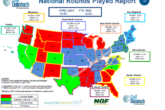

Since the Pandemic in 2020, golf courses have soared. The National Golf Foundation in the 2024 Graffis Report stated:[1]
- Rounds are up. (528 million)
- On-course participation is up. (26.6 million)
- Off-course participation is up. (45.0 million)
- Female engagement is at a high-water mark. (7.0 million)
- Beginners are at record levels. (3.4 million)
- The participant base is becoming increasingly diverse. The number of Black on-course golfers in the U.S. has increased by more than 500,000 (58%)
- Facility revenue and financial health is up.
- Golf course utilization has reached its highest level in decades.
- Closures are down (89.8), and openings are up (23.1).
- More people are playing, watching & reading about golf – in more ways than ever.
In metro areas, tee sheets remain full despite increases in green fees. At private clubs, resignation lists are now waiting waits. Twenty years ago, there were only two golf simulator facilities in the United States. Today there are over 6,000. Through November 2024, rounds were up 2.6% over 2023, setting a likely record in 2024 of 541 million rounds played.
Speaking with golf course management leaders and owners, I learned that they are raising their prices for 2025, limiting the number of annual passes sold, and diluting the benefits of their loyalty programs while simultaneously wondering if there is a ceiling in golf’s growth.
Two articles written by highly accomplished and knowledgeable veterans in early January 2025 presented contrasting views regarding the future of the golf industry.
Martin Slumbers, CEO of the R&A, retired at the end of 2024 after nearly nine years as CEO of The R&A. He had overseen significant initiatives, including the Ladies’ Golf Union merger and the modernization of The R&A’s activities. In his farewell message, he wrote in article titled, “Golf Club Membership Is In Decline. So What Does The Future Hold?[2]
“The traditional members’ golf club has been the beating heart of the sport in this country for more than a century. Members paying a set annual subscription to largely or fully cover the running costs of the establishment. But rising costs across the board in recent times have, by necessity, driven subscription rates higher and higher over the last 20 or so years.
Golf Clubs must look to offer a package that appeals to a broader spectrum of people, not just the traditional golfer. Handing over north of £1,000 per year simply to have access to a golf course just won’t cut it these days.
Clubs must offer excellent and inclusive dining options. They must have a full social calendar with quizzes, theme nights, speakers, singers, dances. They should look to run family events, new member events, open days and the like.
The golf clubhouse is a superb facility that is often under-utilized. It’s a great space that could be more versatile in many cases. Could the old drying room be converted into a gym? Could the function room be used for yoga classes or other non-golfing activities that would appeal to prospective members or non-members prepared to hand over some cash?
Quite simply, golf clubs must think outside the box to continue to be relevant going forward.”
The statement that struck me was, “Handing over north of £1,000 per year simply to have access to a golf course just won’t cut it these days.” He considered paying $1,220 US for unlimited golf did not create sustainable value for the golfer.
In contrast, the talented and very articulate travel writer for Global Golf Post, John Steinbreder wrote in an article titled, Architectural ‘golden age’ keeps expanding[2]:
“In looking at the noteworthy new layouts due to formally come online in 2025, there is one obvious conclusion: the second golden age of course architecture, which for all intents and purposes started three decades ago with the opening of the Sand Hills Golf Club in Mullen, Nebraska, continues in full force.
He lists the following golf courses that will open in 2025:
| Course Name | Architect |
| Brambles, CA | Coore and Crenshaw |
| Broomsedge, SC | Kyle Franz |
| Cliffhangers, MO | Johnny and John Paul Morris |
| Contentment Golf Club, NC | Lester George |
| Crazy Mountain Ranch, MT | Coore/Crenshaw |
| Doon Brae, MI | Ray Hearn |
| High Grove, FL | Gil Hanse and Jim Wagner |
| High Pointe, MI | Tom Doak |
| Loraloma, Texas | David Mclay Kidd |
| Luling Sports, TX | Kyle Franz |
| Macleod, Scotland | Martin Hawtree |
| Mapleton Golf Club, SD | Scott Hoffman |
| Miakka Golf Club, FL | Dana Fry and Jason Straka (Paul Azinger) |
| North Course at Apogee Club, FL | Michael Pascucci and Steve Ross |
| Old Petty, Scotland | Tom Doak |
| Palmetto Bluff, SC | Coore/Crenshaw |
| Rodeo Dunes, CO | Coore/Crenshaw |
| Roost, Cabot Citrus Farms, FL | Kyle Franz |
| Sandglass, FL | Tom Doak |
| Scarecrow Layout – Gamble Sands, WA | David Mclay Kidd |
| South at Apogee Club, FL | Mike Davis and Tommy Fazio |
| The Commons, WI | Coore/Crenshaw |
| Torch Cay, Bahamas | Coore/Crenshaw |
| Travis Club, TX | Beau Welling |
| Upper at Childress Hall, TX | Tom Doak |
| West Course at Apogee Club, FL | Gil Hanse and Jim Wagner |
These 26 golf courses represent perhaps an investment exceeding $400 million, excluding clubhouses. This investment does include the plethora of renovations or restorations occurring at many golf courses currently.
This positive industry sentiment is also reflected in the Golf Inc. January/February 2025 magazine, which just published an article titled “Radical Hospitality.” In it, they forecast that 2025 is expected to be a phenomenal year for golf, with growth in both participation and revenue.
If Martin Slumbers, former CEO of the R&A, believes golfers will not pay $1,220 for unlimited golf per year, how can any of these 26 golf courses become economically sustainable, or will the forecast for phenomenal growth be accurate?
Has the golf market grown sufficiently to support these new facilities, or are they a signal of excess? Has the ceiling for golf been approached?
What do you think?
[1] National Golf Foundation, “The Graffis Report – 2024”, pg 4


Philippe Wattinne
The age pyramid increases towards seniors.
In the next decades, will they have enough revenue to support 1220$ per year to play golf ?
The way golfers use to play is changing, more 9 holes than 18 holes (too long time on a course…)… May be that will also be a factor to be aware by the Golf Courses ?